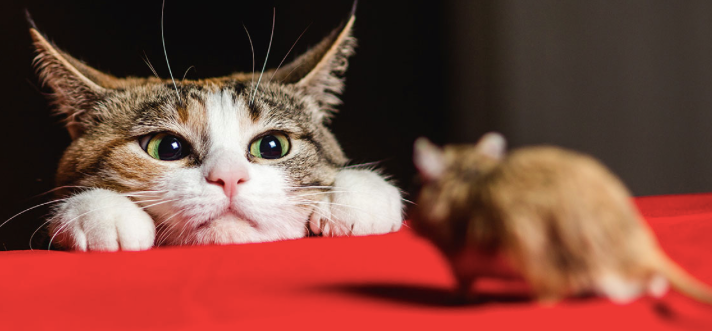
Reading time: 9 minutes
The war against money laundering is undergoing a revolution, one that benefits both sides. For centuries money launderers and those opposing them have been playing a game of cat and mouse. We will start with the mouse which represents money launderers, who are benefiting from the introduction of new technologies, such as digital currencies, online gaming and the dark web. These technologies provide money launderers with new opportunities to clean dirty money. The main aim of any money launderer will always be to distance themselves from dirty money and to make it appear like it has originated from a legitimate source. They know that to keep doing this successfully, they must embrace new technology in an attempt to stay one step ahead of those fighting against them – the cat which represents governments, regulators and law-abiding businesses. The introduction of sophisticated new technology, such as Artificial Intelligence (AI) could be the game changer they have long been looking for. This is because up until now the game of cat and mouse has been completely reactive. By using these new technologies, governments, regulators and law-abiding businesses could for the first time, take a preemptive and even a proactive approach to fighting the war against money laundering.
To understand how things got to this point and where things may be going, we have to know where they have been.
2000 BC
Chinese Merchants and PiratesHistory shows that money laundering has long been in existence, although it has not always had a label. The earliest identified record dates back to China in 2000 BC. Chinese merchants would launder their profits by moving them outside of the country by making use of movable assets to hide profits from the Chinese government. Another early example comes from the high seas. Pirates in the seventeenth century were very adept at laundering their loot, and they had good reason to do so as most had a bounty on their head’s courtesy of the British Government. The game of cat and mouse had begun.
1920s
Al Capone and LanskyAlphonse “Al” Capone is one of the most famous gangsters to have ever lived. In the 1920s he was cleaning his dirty money through a series of businesses, ironically including laundromats. In fact, he was so good at laundering money, he was never found guilty of it; he was instead convicted of tax evasion. Many think it was the imprisonment of Al Capone that forced criminals, such as Meyer Lansky to become organised, making it more difficult for government authorities to identify and prevent their crimes. What we now know as organised crime had emerged.
1989 - 1990
Escobar and the CartelsHaving amassed a fortune of approximately US$30 billion Pablo Escobar is widely recognised as being the wealthiest criminal in history. He and other drug traffickers were the reason why money laundering became recognised as a criminal offence, as governments did not like the power and influence that come from the huge profits generated. All of a sudden Escobar and others had the ability to corrupt and control government officials now known as a Politically Exposed Persons (PEP), or Prominent Influential Persons (PIP). The US Government reacted to this and implemented legislation to deprive drug traffickers like Escobar, of their illicit gains. Soon after, there were similar reactions on the world stage. In 1989, the Financial Action Task Force (FATF) was established and in 1990 it released the first version of its 40 recommendations, which set the international standard for Anti-Money Laundering (AML) measures. One year later, the First EU Money Laundering Directive came into effect. This Europe-wide legislation established a due diligence framework for financial institutions across the continent. The cat had pounced and in doing so, gave money laundering a label it previously did not have.
2001 - 2005
September 11th, 2001The events of September 11th, 2001 were a huge blow to modern society, and they will forever be remembered in history. The events also had a profound impact on AML legislation. In 2001, the US Patriot Act came into effect. In the same year the Second EU Money Laundering Directive was approved and in South Africa the Financial Intelligence Centre (FIC) was established. The FATF also expanded its mandate to deal with the issue of terrorism and global emphasis was placed on strengthening the regulatory framework in response to what had happened. In 2005, the Third EU money Laundering Directive came into effect. It introduced the Risk Based Approach, including Customer Due Diligence (CDD) measures and targeted measures to fight terrorism. Similar measures were implemented in South Africa in 2017 through the FIC Amendment Act. This required Financial Service Providers (FSPs) to a adopt a Risk Based Approach (RBA) and implement a Risk Management and Compliance Programme (RMCP). The cat had shown its claws once again.
2009
Bitcoin and Online GamingBitcoin was introduced in 2009, and since then it is estimated criminals have laundered over UD$2.5 billion using the digital currency. Unsurprisingly, unregulated exchanges with no Know Your Customer (KYC) procedures would attract criminals. The new provisions within the Fifth EU Money Laundering Directive aim to assist in addressing this risk. A relatively new target for money launderers is online gaming. According to Jean-Loup Richet, a research associate at the ESSEC Business School, role-playing games like World of Warcraft and Fortnite are targeted because they are not regulated and there are no clear obligations for game operators to follow. This makes it difficult for game operators to identify criminal activity which remains advantageous to a money launderer. The cat will need to think how it is going to pounce here, as it is being outwitted, for now.
2000s
Artificial IntelligenceOne of the most compelling use cases for AI is the war against money laundering. For example, AI has the ability to enhance the effectiveness and efficiency of client on-boarding processes and CDD investigations. AI can drive smarter decisions and do so more quickly and more accurately than a human can. It can gather and analyse data from various sources and establish risk ratings for customers, as well as identify new behaviours that would alert investigations. It can also lower costs, by redirecting the efforts of human experts to more focused areas and can be adaptive to new typologies and new societal changes, such as the possible movement to a contactless society. The sophistication offered by this, and other technologies like biometrics and blockchain lessens the opportunity for money launderers to succeed.
Conclusion
Everything considered, the money laundering war is essentially a reactive one. Money launderers have had to become better organised and constant opportunists, while governments, regulators and law-abiding businesses have had to constantly react to key events in history by strengthening regulatory frameworks and preventative measures. To win the money laundering war, the victor will need to hold a preemptive and pro-active position. Up to this point it has not been possible. However, with the introduction, on-going development and use of AI, the cat could finally keep catching and outwitting the mouse.
It is important to realise that AI cannot be expected to operate effectively without human experts. We at Monivation see this as being a human centered partnership, which is why our Digital Client On-boarding tool, the Digital Compliance Officer (DCO) is driven by augmented intelligence.
Contact Monivation for further information on the DCO and our other service offerings - Specialised Due Diligence and Professional Services.
Article written by:






4 comments
Leo 2020-04-03
Good article Mr Turner, wasn’t aware money laundering went all the way back to 2000BC. A good AML service! The Colombians will soon be coming for you.
Esmé Mody 2021-07-07
Thank you for your comment. We hope that our articles continue to be both interesting and insightful.
Mixer tap black 2021-07-07
Truly wonderful short article, I wish I can see many more blog posts like this!
Esmé Mody 2021-07-07
Thank you, please follow us on LinkedIn for more interesting posts.